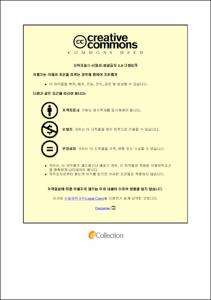소라페닙과 DDC (Sodium diethyldithiocarbamate) 조합 요법으로 PI3K/Akt/mTOR 경로 억제를 통한 B형 간염 유래 간암세포에서 세포자멸사를 유도함에 대한 연구
- Alternative Title
- Combination of sorafenib and sodium diethylthiocarbamate synergistically induce cell death in hepatitis B virus derived liver cancer via suppression of the PI3K/Akt/mTOR pathway
- Abstract
- 목적: 본 연구는 디설피람 유도체인 DDC (sodium diethyldithiocarbamate)를 소라페닙과 조합하여 B형간염 유래 간암세포에서의 항암 작용 가능성을 확인하고자 하였다.
대상 및 방법: 간암 조직과 세포주에서 실시간 폴리머아제 연쇄반응(qRT-PCR)과 면역블롯팅(immunoblotting)을 사용하여 초과산화이온1 (SOD1)과 B형간염 바이러스 단백질(HBx)의 발현 수준을 확인하였다. B형간염 양성 간암세포와 B형간염 음성 간암 세포에서 PI3K/Akt/mTOR 경로를 비교하였다. 소라페닙과 DDC 조합요법에서 세포 생존율, 활성산소 수준 및 세포자멸사 지표들을 평가했고, 소라페닙과 DDC 의 경구 공급과 관련하여 이종이식 생체 내 실험을 수행하였다.
결과: 환자 조직 검체와 B형간염 양성 세포에서 HBx와 SOD1의 발현이 증가되어 있었으며 둘 사이에 유의한 상관관계가 있었다. DDC 치료는 HepG2.2.15 세포에서 SOD1과 HBx의 발현을 효과적으로 감소시켰다. DDC와 소라페닙의 조합요법은 HBx의 발현을 감소시켰다. 소라페닙은 B형간염 양성 세포에서 PI3K/Akt/mTOR 경로를 억제하였으며, 이는 DDC에 의해 더 강화되어 암세포 생존율을 감소시켰다. 그러나 세포자멸사 지표들의 유의한 증가를 보이지는 않았다. 이종이식 생체 내 실험에서 소라페닙과 DDC 조합요법의 경구 투약은 종양의 성장을 억제하였다.
결론: DDC와 소라페닙의 조합요법은 B형간염 유래 간암세포에서 SOD1과 PI3K/Akt/mTOR 경로에 효과적으로 작용한다. 이 조합요법은 SOD1의 발현을 감소시키고, 산화 스트레스를 유도하며, 세포 생존율을 억제함으로써 B형간염 유래 간암세포의 치료에 효과적인 전략이 될 수 있다.|Background/Aims: This study explored the anti-cancer potential of combining sodium diethyldithiocarbamate (DDC), a disulfiram derivative, with sorafenib in HBV-positive liver cancer cells.
Methods: We assessed the expression levels of SOD1 and HBx using qRT-PCR and immunoblotting in liver cancer samples and cell lines. The PI3K/Akt/mTOR pathway was compared between HBV-positive and HBV-negative liver cancer cells. Cell viability, levels of reactive oxygen species, and apoptotic markers were examined in response to sorafenib and DDC combination treatment. Furthermore, we conducted an in vivo xenograft experiment involving oral gavage of sorafenib and DDC.
Results: Patient tissue samples and cells that were positive for HBV showed increased expressions of HBx and SOD1, with a significant correlation between the two. DDC treatment effectively reduced the expression of SOD1 and HBx in HepG2.2.15 cells. When combined, DDC and sorafenib synergistically decreased the expression of HBx. Sorafenib inhibited the PI3K/Akt/mTOR pathway in HBV-positive cells, and this inhibition was further enhanced by DDC, leading to decrease in cancer cell viability. However, the apoptotic markers did not show a significant increase. In an in vivo xenograft model, the combined oral administration of sorafenib and DDC synergistically inhibited tumor growth.
Conclusions: The combination of DDC and sorafenib effectively targets SOD1 and the PI3K/Akt/mTOR pathway in HBV-positive liver cancers. By reducing SOD1 expression, inducing oxidative stress, and suppressing cell viability, this combination therapy presents a promising strategy for the treatment of HBV-related liver cancers.
- Issued Date
- 2024
- Awarded Date
- 2024-08
- Type
- Dissertation
- Alternative Author(s)
- Yong Jae Kwon
- Affiliation
- 울산대학교
- Department
- 일반대학원 의학과
- Degree
- Doctor
- Publisher
- 울산대학교 일반대학원 의학과
- Language
- eng
- Rights
- 울산대학교 논문은 저작권에 의해 보호받습니다.
- Appears in Collections:
- Medicine > 2. Theses (Ph.D)
- 파일 목록
-
-
Download
 200000807756.pdf
기타 데이터 / 1.71 MB / Adobe PDF
200000807756.pdf
기타 데이터 / 1.71 MB / Adobe PDF
-
Items in Repository are protected by copyright, with all rights reserved, unless otherwise indicated.